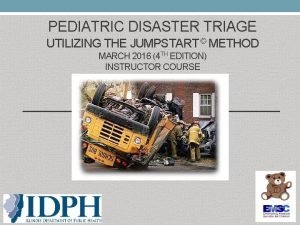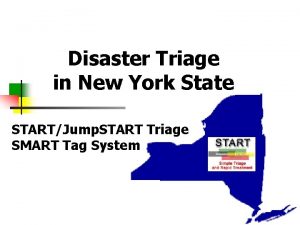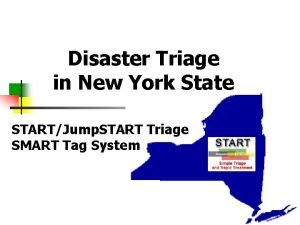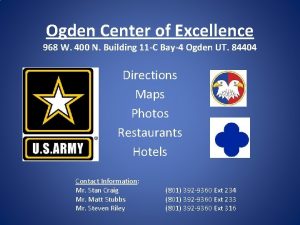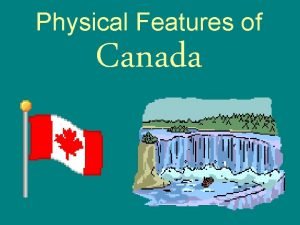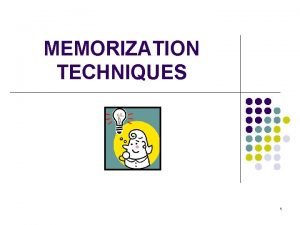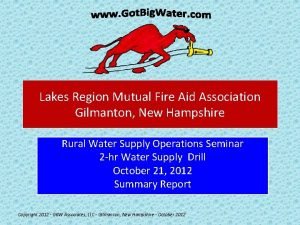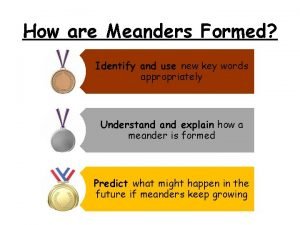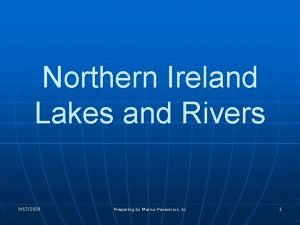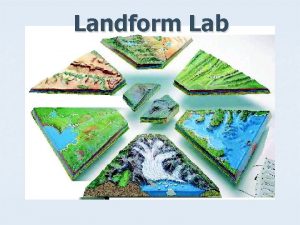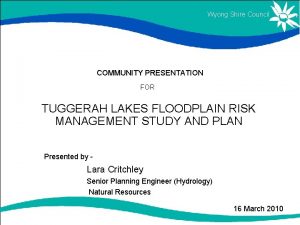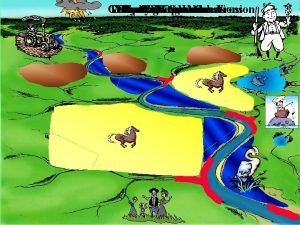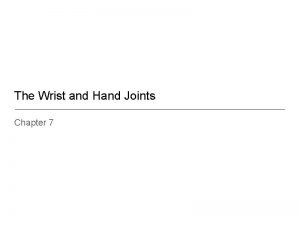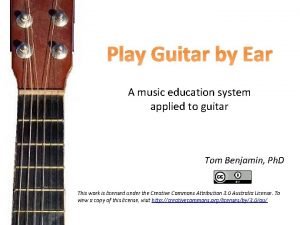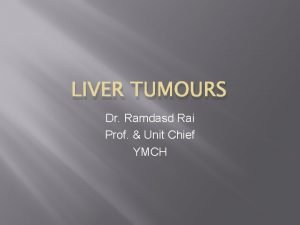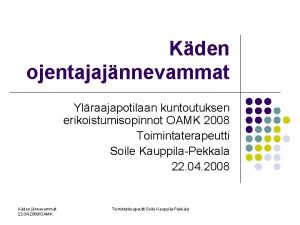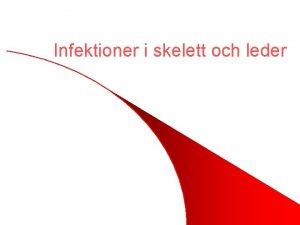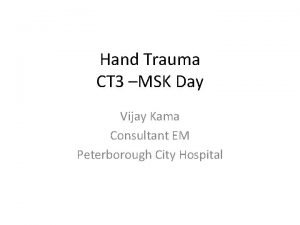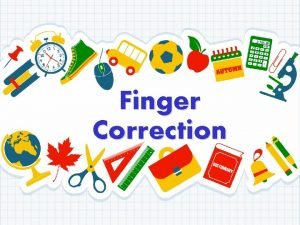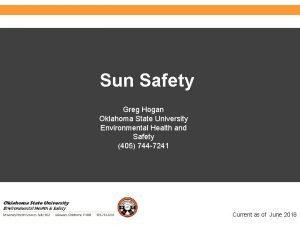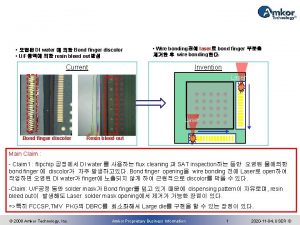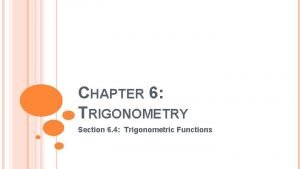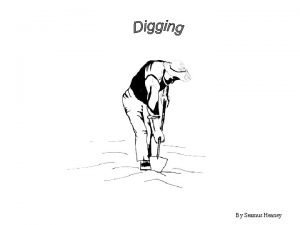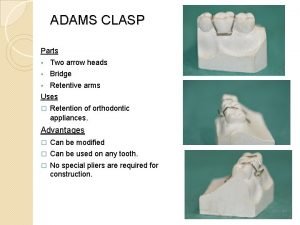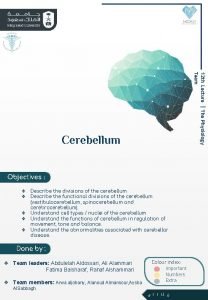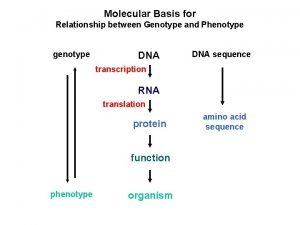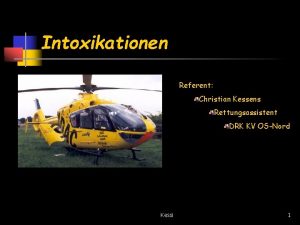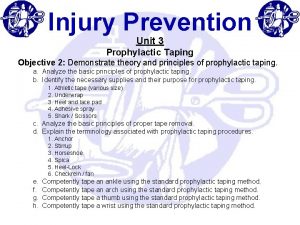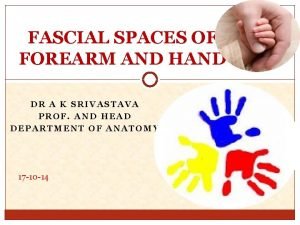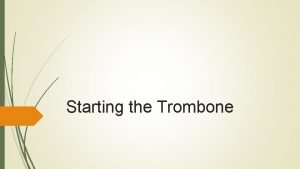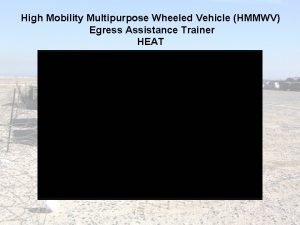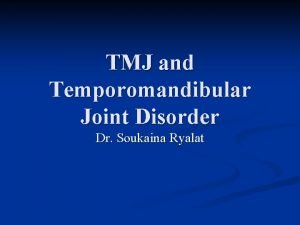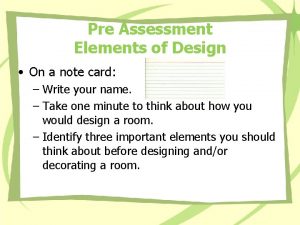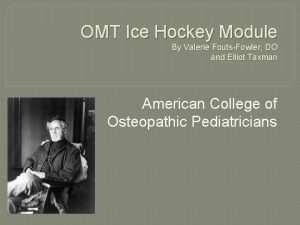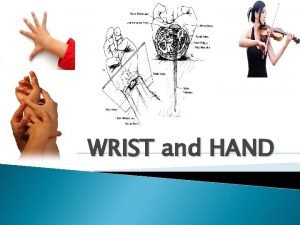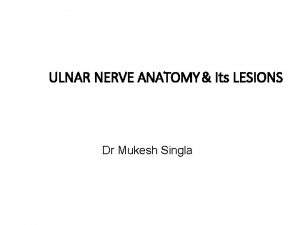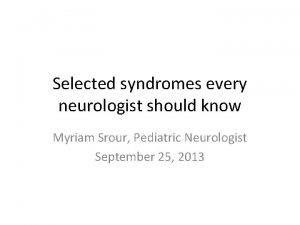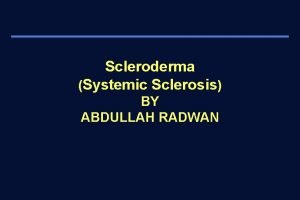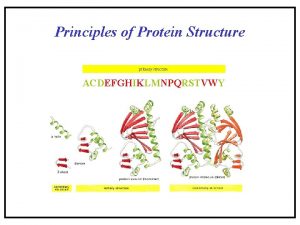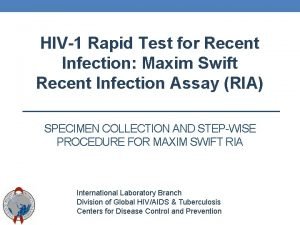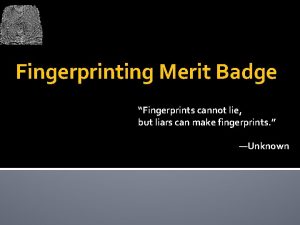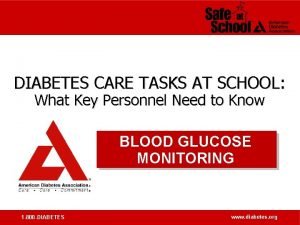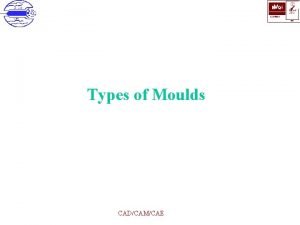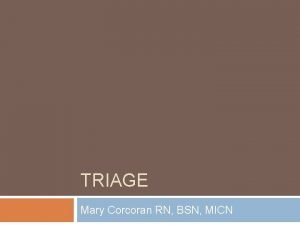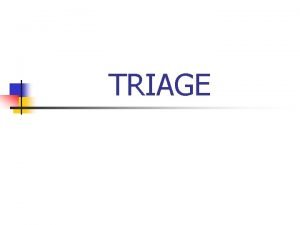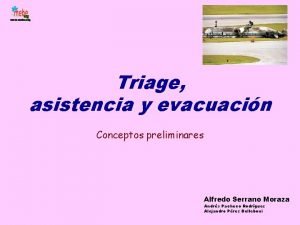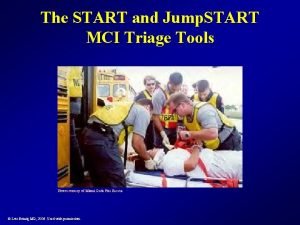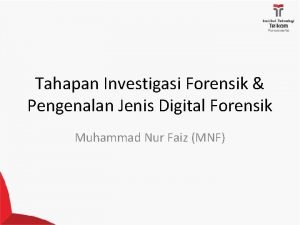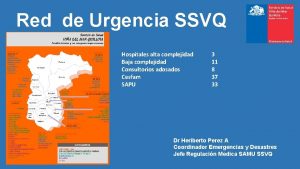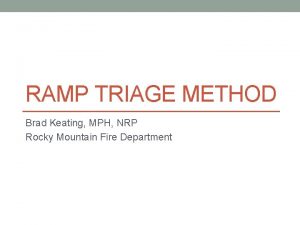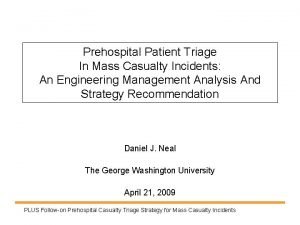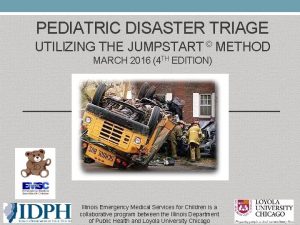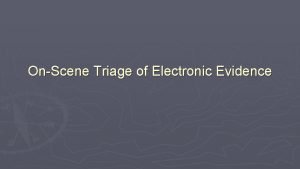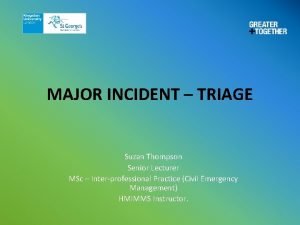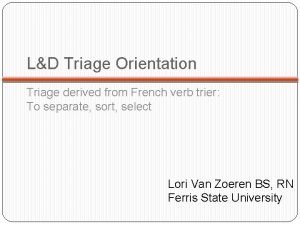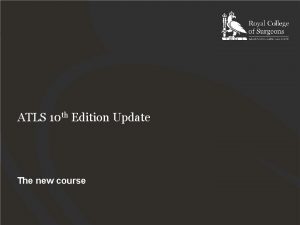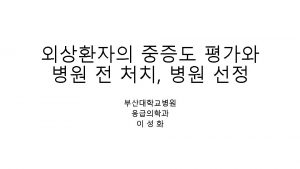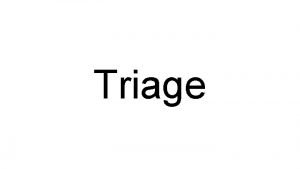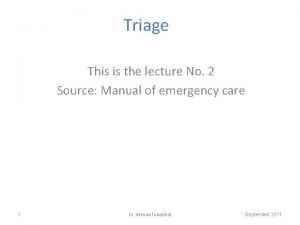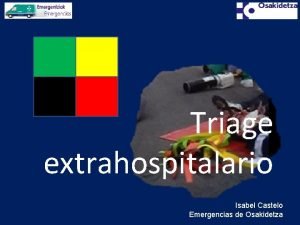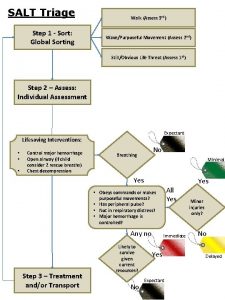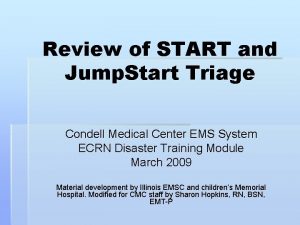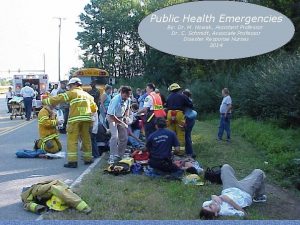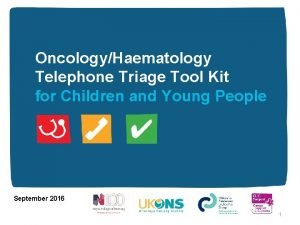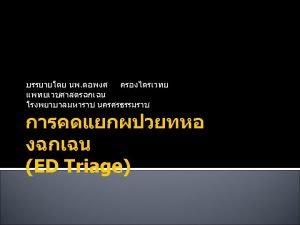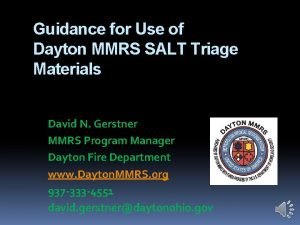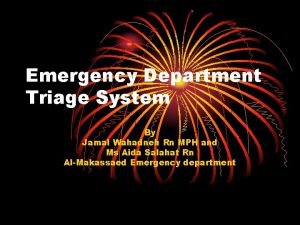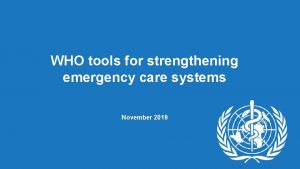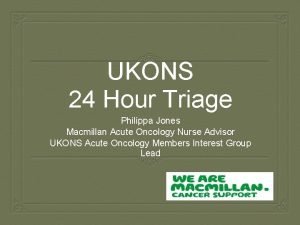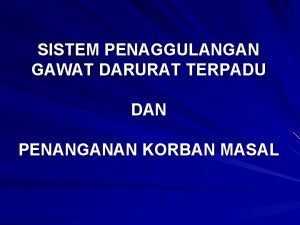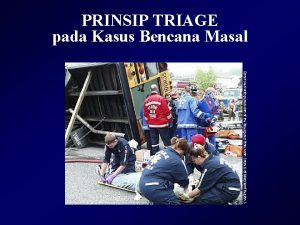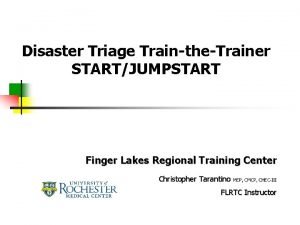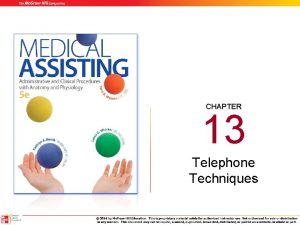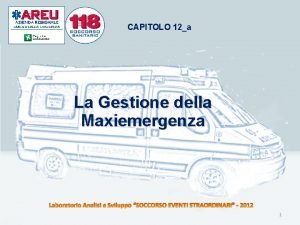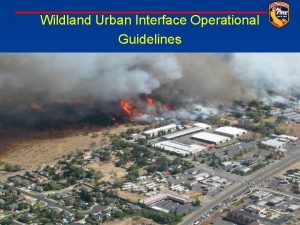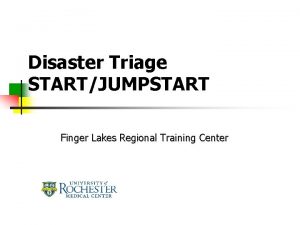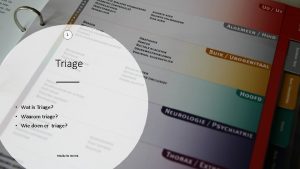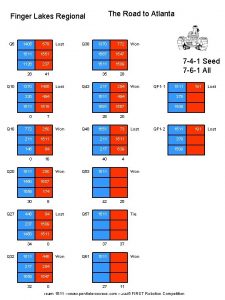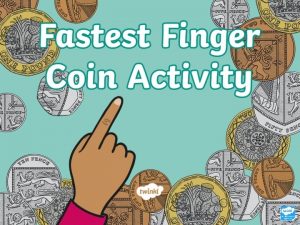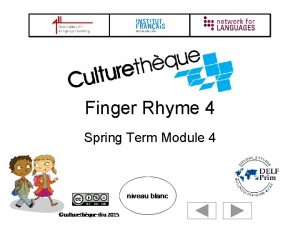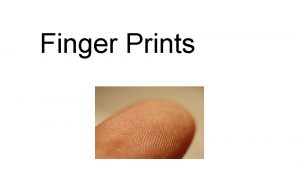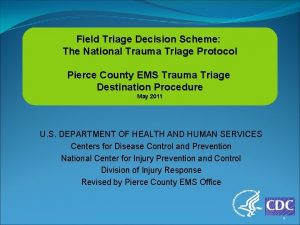Disaster Triage TraintheTrainer STARTJUMPSTART Finger Lakes Regional Training


























































































































































































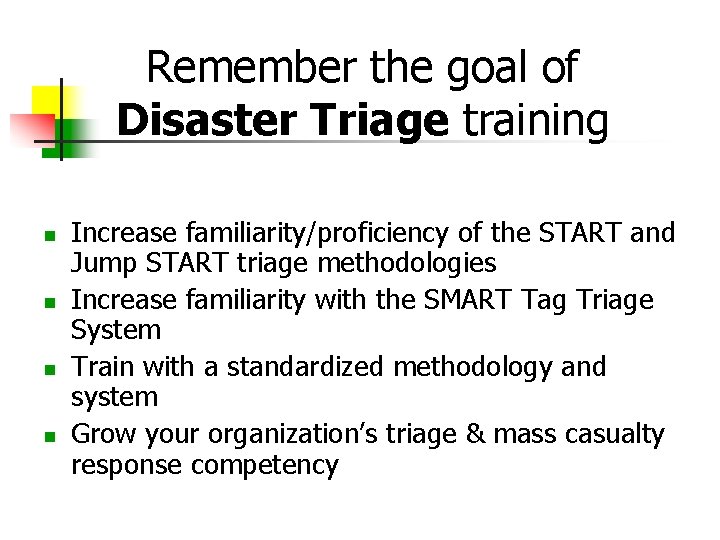
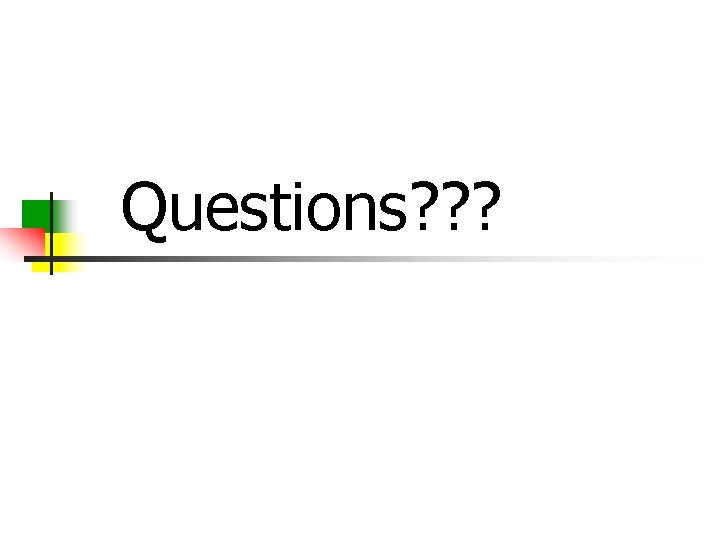
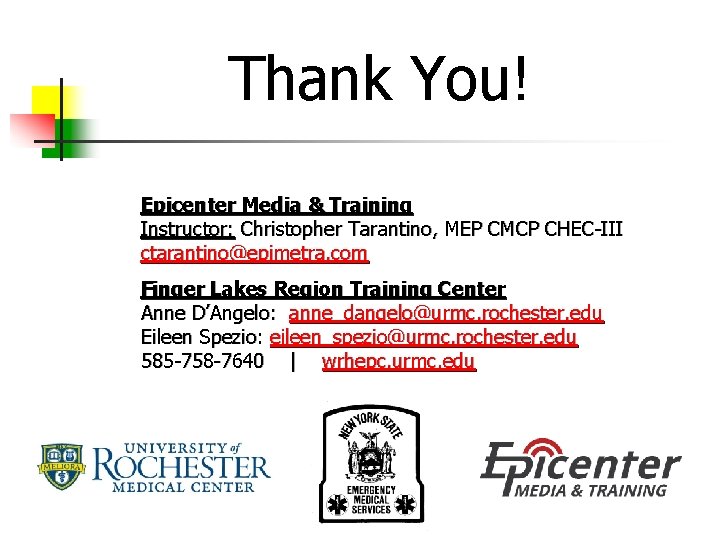
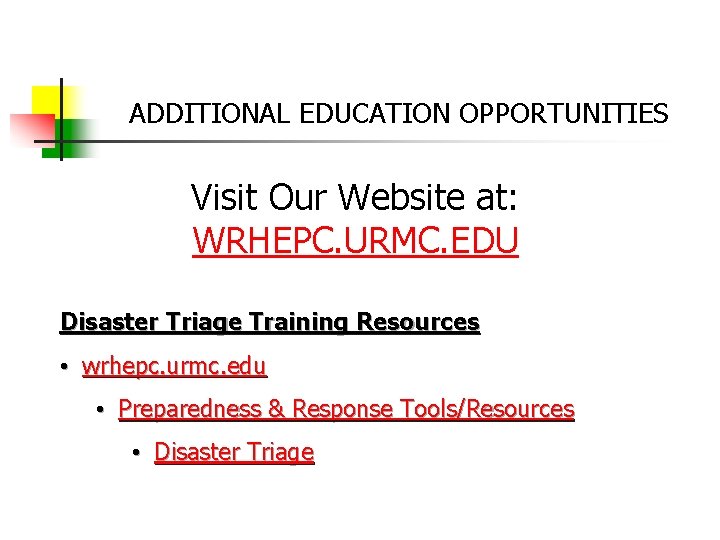
- Slides: 190

Disaster Triage Train-the-Trainer START/JUMPSTART Finger Lakes Regional Training Center Christopher Tarantino MEP, CMCP, CHEC-III FLRTC Instructor

AGENDA • Housekeeping • Sign in • Restrooms • Emergency exits • Mobile devices • Introductions • Presentation • Scenario & Skills • Train-the-Trainer Content • Additional Resources

Objectives: Define a Mass Casualty Incident and the unique challenges of an MCI Understand the differences between dayto-day triage and triage during an MCI Increase the region’s healthcare providers’ awareness of disaster triage

Objectives 1) Define triage and mass casualty 2) Review the dynamics of START triage 3) Review use of the SMART tagging system 5) Demonstrate competency in the START triage method in a variety of scenarios 6) Demonstrate competency in the SMART triage tag and Jump. Start.

What is a Mass Casualty Incident? ANY event that overwhelms the available resources. By available resources, this could mean that we don’t have enough ambulances, enough personnel or enough hospital beds. It could be: Natural Accidental or Intentional event.

The Problem Casualties Resources

Is There A Set Number of Casualties To Be Considered A Mass Casualty or Disaster? No There is no set number associated with declaring a disaster. At times the number of critical patients might impact you more than just overall numbers.

What is the Goal of MCI Management?

The Objective Casualties Resources

GOAL: TO SAVE THE LARGEST NUMBER OF SURVIVORS FROM A MULTIPLE CASUALTY INCIDENT

Considerations During an MCI Response Supply vs. Demand Resource Allocation Coordination Medical Management Ethics

Types of Common MCI’s Highway Accidents Air Crashes Major Fires Train Derailments Building Collapses Explosions Terrorist Attacks Hazardous Materials Releases Earthquakes Tornadoes Hurricanes Floods

What Could Be an MCI For You? Transportation Accident Fire Hospital Overloading Hospital Evacuation February 2008: 390 Pile Up January 2005: 390 Bus Accident

What Could Be an MCI For You? § Sporting Event § Hazmat Incident § Loss of Power § Severe Weather Watkins Glen Speedway

Managing Mass Casualty Incidents Would any of those situations lead to shortage of personnel & equipment resources? Would decisions and changes need to be made in how you do business? Altered Standards of Care Priorities

Hospital Considerations Transition from the EMS patient to hospital patient Dealing with self presenting patients

Transportation Distribution Patient Transport - 29 US Disasters On foot Other Bus Taxi Patient transport - Oklahoma Bombing On foot Other Private car Police EMS Quarantelli, Delivery of Emergency Services in Disasters, Assumptions and Realities EMS Private car Injury prevention database, OK Dept of Health

BALI NIGHT CLUB BOMBING ”As bad as the scene was 20 minutes after the blast, it only got worse. Patients who could self-evacuate generally had relatively minor injuries. They arrived on foot, by taxi and by motorcycle, and they were treated as they came in. ” “But then the ambulances started to arrive with the most serious patients —the burn victims…” October 12, 2002 “By then, though, the operating rooms were completely full. They had to wait”. Dr. Tjakra Wibawa Sanglah Trauma Center

Boston, MA 2013 During the Boston Marathon on April 15, 2013, two pressure cooker bombs exploded at 18: 49, killing 3 and injuring 264 people. The bombs exploded about 13 seconds apart and was located 210 yards from each other. They were placed near the finish line on Boylston Street

Boston Marathon Bombing 04/13

Blast The blasts blew out windows on adjacent buildings but did not cause any structural damage.

Confusion? Some runners continued to cross the line until 2: 57 p. m. EDT, 7 minutes after the explosions.

On Scene Rescue workers and medical personnel were on hand to assist runners and bystanders rushed to help the wounded in the immediate aftermath. The 264 people injured were treated in 27 local hospitals. At least 14 people required amputations as a result of the blasts


Scene Safety Many people dropped backpacks and other bags as they fled, requiring each to be treated as a potential bomb. A number of news reports stated that more bombs had been found nearby and the Boston Police Bomb Squad said they would perform a controlled explosion on the 600 block of Boylston Street, but in the end no other bombs were found. The Navy sent one of its bomb-disposal units to Boston to help local authorities

Communication Limitations? The Massachusetts Emergency Management Agency suggested people trying to contact those in the vicinity use text messaging, instead of voice calls, because of crowded cell phone lines. Cell phone service in Boston was congested but remained in operation, despite some local media reports stating that cell service was shut down to prevent cell phones from being used as detonators

Getting Information Out The American Red Cross helped concerned friends and family receive information about runners and casualties. The Boston Police Department also set up a helpline for people concerned about relatives or acquaintances to contact and a line for people to provide information

Victim Helps Prevent Other Attacks? Jeff, a victim who lost both legs, was adjacent to the location of one of the bombs. Upon recovering consciousness, he asked for pen and paper and wrote a note to the FBI, "bag, saw the guy, looked right at me". He was later able to provide detailed descriptions to the authorities of a suspect who was seen placing a backpack beside him at the bombing scene two and a half minutes before it exploded, enabling the photo to be identified and circulated quickly

Internet Trained…It’s That Easy? During an initial interrogation in the hospital, Dzhokhar said Tamerlan was the mastermind. He said they were motivated by extremist Islamist beliefs and the wars in Iraq and Afghanistan, and that they were selfradicalized and unconnected to any outside terrorist groups, but that they had learned how to build explosive devices from an online magazine of the al-Qaeda affiliate in Yemen.

Internet Trained? He said that he and his brother had decided after the Boston bombings to travel to New York City to bomb Times Square. Dzhokhar was charged on April 22, while still in the hospital, with use of a weapon of mass destruction and malicious destruction of property resulting in death

Injury & Treatment A number of the injuries were grievous, requiring intensive care, and appeared to be "war-like injuries" of mutilation, shrapnel wounds, and dismemberment. The trauma surgery chief at Boston Medical Center said: "We see patients like this, with mangled extremities, but we don't see 16 of them at the same time, and we don't see patients from blast injuries

Can You Hear Me? Doctors described removing "ball-bearing type" metallic beads a little larger than BBs, and small carpenter-type nails about 1 to 2. 5 centimeters (0. 4 to 1. 0 in) long. Similar objects were found at the scene. The New York Times stated that, according to doctors, because the bombs were low to the ground, the injuries mainly affected legs and feet instead of abdomens, chests, and heads, and as a result few deaths occurred. Some suffered ruptured eardrums

Systems Are Activated Brigham and Women’s Hospital, received thirty-one victims, twenty-eight of them with significant injuries. Seven arrived nearly at once, starting at 3: 08 P. M. All required emergency surgery. The first to go to surgery—a patient in shock, hemorrhaging profusely, with inadequate breathing and a near-completely severed leg—was resuscitated and on an operating table by 3: 25 P. M. , just thirty-five minutes after the blast. The rest followed, one after the other, spaced by just minutes. Twelve patients in all would undergo surgery—mostly vascular and orthopedic procedures—before the evening was done.

Where Did They All Go? Massachusetts General Hospital also received 31 victims —at least four of whom required amputations. Boston Medical Center received 23 victims. Beth Israel Deaconess Medical Center handled 21 victims. Boston Children’s Hospital took in 10 children, ages two to twelve. Tufts Medical Center and St. Elizabeth’s Medical Center each treated 18 victims.

WWYD - What Would You Do? If an explosion, bombing or any event which created a large number of injured and dying people happen while you were on duty: What would you do to care for the injured? How would you sort the priority of treatment? How would you prioritize transport? ANSWER: You would use the SMART Tag Triage System

Triage First, what is Triage? Triage is the process of prioritizing or sorting of sick or injured people for treatment according to the seriousness of the condition or injury.

Triage: Sorting of Patients You can’t commit to “one-on-one” care You have to be fast – 30 sec or less per patient Very limited treatment is provided Manually open airways Clear airway with finger sweep Control major bleeding

Primary and Secondary Triage Primary triage 1 st contact Assign triage category Secondary triage ongoing process that takes place after the patient has been moved to a treatment/holding area awaiting transport.

Types of Triage Primary On scene prior to movement or at hospital (self transports) Secondary Incident dependent, probably prior to or during transport or upon arrival to hospital

Triage Categories Red (1)= immediate - critical patient Yellow (2)= delayed - serious patient that could wait until all reds have been transported Green(3) = ambulatory / hold – minor injuries Black = deceased (expectant)

Disaster Triage Systems MASS – “Move, Assess, Sort, Send” ESI – “Emergency Severity Index” SALT – “Sort, Assess, Lifesaving Interventions, Treatment/Transport” START/Jump. START

Disaster Triage Systems MASS ESI SALT START/Jump. START “Simple Triage and Rapid Treatment”

The “START” System of Triage Simple triage and rapid treatment (START) is a triage method used by first responders to quickly classify victims during a mass casualty incident (MCI) based on the severity of their injury.

The “START” System of Triage Simple Triage and Rapid Treatment (START) The method was developed in 1983 by the staff members of the Newport Beach Fire Department located at Hoag Memorial Hospital in Newport Beach, CA Easy to use Focus is on signs/symptoms Fast

START – 4 things to think about… Ability to follow directions and walk Respiratory effort Pulses/perfusion Mental status

The “START” System of Triage using START Triage, evaluate victims and assign them to one of the following four categories: Walking wounded/minor (green) Delayed (yellow) Immediate (red) Deceased/expectant (black)

Triage Protocol (START)


Primary Triage The Scene

Incident Command System Emergency Dept. Triage Immediate Treatment Delayed Minimal Transport Expectant

“START” Focus on tagging the patients BEGIN… Clear out all ambulatory patients – tag Green Rest of the patients require MORE triage – 3 steps: They will be either red, yellow or black. Respiratory effort Pulses/perfusion Mental status

Primary Triage The first attempt at balancing resources and casualties/injured

The “Greens” Once they walk toward you – designate a place for them to go Someone needs to tag them green Someone needs to stay with them & keep them informed

Something To Think About…. Keep in mind that in a larger scale event, patients may be spread out over a large area or even on several floors or rooms in a building. In this type of situation, you may encounter further ambulatory patients as you progress. They are still tagged green – direct them to the area that you selected for the “greens” to stage.

START – Step 1 Respiratory Effort Not breathing – manually open their airway If they start breathing - tag RED If they don’t start breathing – tag BLACK Breathing >30 or <10 = tag RED Breathing normal 10 -30 = go to next step

Primary Triage Determining whethere is an airway and breathing

Primary Triage If breathing, at what rate & is it good enough?

START – Step 2 Pulses/Perfusion Check for Radial pulse absent = tag RED Radial pulse present = go to next step

Circulatory Check…

Primary Triage They have an airway, are breathing. Are they circulating blood sufficiently?

START – Step 3 Mental Status You are assessing whether or not the person can follow a simple command. “Squeeze my hand” Can follow a simple command = tag YELLOW Cannot follow a simple command = tag RED

Primary Triage A B C Mental Status

Triage Coding Priority Treatment Color Immediate 1 RED Urgent 2 Yellow Delayed 3 Green Dead 0 Black

PRIORITY 3 Not injured or “Walking wounded” Have motor, respiratory, mental function DELAYED

Example Patient walks over to you and has an obvious broken arm Respirations are 22 Pulse is 124 (Radial) He is awake, alert, and crying

PRIORITY 1 • Opening airway, starts to breathe • Breathing is greater than 30 or less than 10 • Delayed capillary refill time (> 2 seconds) • Absent radial pulses • Bleeding that needs to be controlled • Does not follow instructions Immediate

Example Patient has an open head Wound, bleeding controlled Respirations are 16 Pulse is 88 (Radial) He is unconscious

PRIORITY 2 • Did not move out, when asked • Airway OK • Breathing within 11 and 29 • Capillary refill less than 2 seconds or radial pulses present • Can follow instructions to move unaffected limb Urgent

Example Patient states he can’t move or feel his legs Respirations are 26 Pulse is 110 (Radial) He is awake and oriented

EXPECTANT/DEAD Still require resources Focus of care is comfort Psychologically most challenging for healthcare providers

Examples Patient gurgles but can’t maintain an open airway and Is not breathing Weak Carotid Pulse She is unresponsive

Secondary Triage Generally used when there is an extended duration event After initial color coding triage Healthcare professionals who respond to the scene or PH/Hospital response teams may be utilized to further determine who gets transported from scene first

Secondary Triage

Pediatric Triage • Children are involved in mass casualty incidents • The over prioritizing of children will take valuable resources away from more seriously injured adults • Triage systems based on adult physiology will not provide accurate triage

Pediatric Modifications for START = JUMPSTART Kids Are A Little Different Expect children to be part of a disaster Jump. Start – modified START for kids Designed for children ages 1 -8 y/0

Pediatric Modifications RPMs Respiratory effort – not breathing Open the airway If the patient starts breathing tag RED If apneic and no pulse tag BLACK If apneic with pulse try 5 rescue breaths If still apneic tag BLACK If starts breathing tag RED Respirations < 15 or > 45 tag RED Respirations 15 -45 go to next step (Pulse)

Pediatric START - RPMs Pulse No distal pulse – tag RED Pulse present go to next step (Mental) Mental status – use AVPU Alert, responds to verbal or responds to pain = tag YELLOW Inappropriate response, posturing or unresponsive tag RED

Children OVER 1 year old

All Babies Under 1 Year Get Secondary Triage (Meaning No Greens!). Follow Jump. Start to Determine Yellow or Red.

The SMART Tape ™


Triage Tags Types of triage tags There are several types of tags on the market New York State uses the SMART Tag. Advantages of using triage tags Alerts providers to priorities Prevents re-triage Tracking system

New York State Approved Triage Tag

SMART TRIAGE TAG A kit versus a group of tags Larger, easier to see colors Patient condition changes, tag changes Larger area for documentation Better Patient tracking system Decon/Hazmat capabilities

Size Matters! Smart tag has a larger colored area Can be seen at night Numbers and colors for the colorblind Less chance of error no tear of section Documentation area Secondary triage/assessment/treatment

THE COLORS OF THE TAG Only 1 color will show.

Documentation

Documentation for Secondary Triage

Documentation for Secondary Triage

Dead is Dead

START is not a system for determining resource allocation. The classification algorithm used in START does not depend on the number of victims or on the number of resources available to treat them Some attempt has been made to prioritization of patients within a category, such as folding down a triage tag corner to signify an emergent transport need.

It’s a RED that is VERY Critical

What about HAZMAT

It Has a System to Account for Patients Triage Levels

SMART Tag Triage System

SMART Triage Pack Contents Dynamic Tags (20) Dead Tags (10) Pencils Cylume Sticks Patient Count Card/Protocol SMART Pediatric Tape

Patient Tracking Document minimal information depending on your situation Primary Triage Very little documentation Secondary Triage More information More assessment and treatment will be done Smart Tag has a command board to keep track of where the patient went.

Important Info Remember that anyone who can walk at the scene will be tagged GREEN. The patient could deteriorate or you may determine a different priority when you re-triage at the scene or the ED.

Important Info If a bus-load of “greens” is sent to you from the incident site, you can hold them on the bus in the ED parking lot until you are ready for them. Just make sure someone boards the bus to see what you have in case anyone needs immediate attention.

Morgue – Tagged Black Establish an area away from other patients It should be a secure area away from on-lookers, media, etc. Accessible for you and coroner staff At scene…

In The Treatment Area Patients should be separated as tagged

In The Treatment Area Designate someone to oversee the entire treatment area or each color depending on scale of the event Additional treatment can be provided in this area while awaiting transport Secondary triage is ongoing – patients can and do deteriorate.

Scenario – Practical Application

Instructions Individual patients will be shown on the screen (with signs/symptoms) 1. 2. 3. Follow SMART Triage methodology Identify important info (not all signs/symptoms are pertinent) Make initial triage decision(s)

Scenario #1 An improvised explosive device is detonated at a large outdoor sporting event. At least 50 people are confirmed injured. EMS is on scene, but patients begin to arrive at your hospital before EMS. Triage and “Tag” the following patients.

Scenario #1 What are your immediate priorities? Who will conduct triage? Where? How do you expect these priorities and considerations to evolve as time progresses?

Patient #1 Apneic Pulse-less Missing LUE

Patient #1 Apneic Pulse-less Missing LUE

Patient #2 Eviscerated bowel Multiple penetrating wounds to chest & head Brain matter exposed Unresponsive to tactile stimuli

Patient #2 Eviscerated bowel Multiple penetrating wounds to chest & head Brain matter exposed Unresponsive to tactile stimuli

Patient #3 Abd. Tenderness and minor penetrating trauma Ambulating A&Ox 3 RR 24 Strong radial pulse

Patient #3 Abd. Tenderness and minor penetrating trauma Ambulating A&Ox 3 RR 24 Strong radial pulse

Patient #4 Multiple penetrating injuries, blood in ears Responds only to pain Airway clear RR 20 Strong Radial pulse

Patient #4 Multiple penetrating injuries, blood in ears Responds only to pain Airway clear RR 20 Strong Radial pulse

Patient #5 Extremity fractures, blood in ears A&Ox 3 RR 26 Strong radial pulse

Patient #5 Extremity fractures, blood in ears A&Ox 3 RR 26 Strong radial pulse

Patient #6 Child, screaming Minor lacs, blood in ears RR 30 Moving all extremities

Patient #6 Child, screaming Minor lacs, blood in ears RR 30 Moving all extremities

Patient #7 Amputated fingers, head injury A&Ox 3 Dizzy RR 24 Smells like beer

Patient #7 Amputated fingers, head injury A&Ox 3 Dizzy RR 24 Smells like beer

Patient #8 Chest pain, SOB No trauma noted RR 34 Shallow Weak radial pulse

Patient #8 Chest pain, SOB No trauma noted RR 34 Shallow Weak radial pulse

Patient #9 Blood in nose, mouth and ears Not breathing

Patient #9 Blood in nose, mouth and ears Not breathing What would you do?

Patient #9 Blood in nose, mouth and ears Not breathing RR 10 with manual opening

Patient #10 Some penetrating trauma Unresponsive Apneic No radial pulse Carotid 130/min

Patient #10 Some penetrating trauma Unresponsive Apneic No radial pulse Carotid 130/min

Patient #11 Arterial bleed from leg Responsive to pain RR 34 No radial pulse Carotid 130/min

Patient #11 Arterial bleed from leg Responsive to pain RR 34 No radial pulse Carotid 130/min

Patient #12 Minor lacs Crying Ambulatory RR 24

Patient #12 Minor lacs Crying Ambulatory RR 24

Patient #13 Deviate trachea RR 40 Weak radial pulse +JVD Cyanosis

Patient #13 Deviate trachea RR 40 Weak radial pulse +JVD Cyanosis

Patient #14 Open fracture of RUE Non-ambulatory A&Ox 3 RR 26 Strong radial pulse

Patient #14 Open fracture of RUE Non-ambulatory A&Ox 3 RR 26 Strong radial pulse

Patient #15 100% TBS burns (partial and full) A&Ox 2 RR 36 Coughing Strong radial pulse

Patient #15 100% TBS burns (partial and full) A&Ox 2 RR 36 Coughing Strong radial pulse

Patient #16 CP, SOB Slurred speech R sided weakness A&Ox 1 RR 24 Strong radial pulse

Patient #16 CP, SOB Slurred speech R sided weakness A&Ox 1 RR 24 Strong radial pulse

Patient #17 Avulsion RUE Arterial bleed A&Ox 2 RR 30 “I’m thirsty”

Patient #17 Avulsion RUE Arterial bleed A&Ox 2 RR 30 “I’m thirsty”

Patient #18 Open fractures BLE Blood in ears A&Ox 3 RR 28 Strong radial pulse

Patient #18 Open fractures BLE Blood in ears A&Ox 3 RR 28 Strong radial pulse

Patient #19 Hysterical, screaming Blood in ears A&Ox 3 RR 36 Strong radial pulse

Patient #19 Hysterical, screaming Blood in ears A&Ox 3 RR 36 Strong radial pulse

Patient #20 Child Cyanotic from nipple line up Apneic

Patient #20 Child Cyanotic from nipple line up Apneic

Questions? ? ?

Now, let’s practice what we have learned…

Scenario#1 You are assigned the duty of triage officer at a local factory where an explosion has taken place due to a gas leak. Utility workers have turned off power and gas at this time and the scene is safe. There are 435 workers at the site and many were in the area of the explosion.

Scenario#1 The following patients (#1 thru #5) are involved in a worksite explosion. Looking around, you visualize 40 – 50 workers involved. You begin the triage process…

Patient #1 You are assigned to triage at a factory where an explosion has taken place. According to the START Triage, when you assess pulses, you would check: A) B) C) D) Radial Pulses Pedal Pulses Femoral Pulses Carotid Pulses

Patient #1 According to the START Triage and PMS criteria, when you assess pulses, you would check: A) Radial Pulses NOTE: Checking peripheral pulses would give you an idea of BP. The presence of a radial pulse would mean a BP systolic BP of 80 -90 range

Patient #2 You notice this patient is not breathing, you would A) Tag Black and rapidly go to next patient B) Tag Red, hopefully that he will begin to breath shortly, C) Don’t waste time with tagging process and proceed to next patient. D) Open the Airway, tag Red if he starts to breath.

Patient #2 You notice this patient is not breathing, you would D) Open the Airway, tag Red if he starts to breath. NOTE: Start Triage does allow you to open an airway, if he starts to breath, tag red, if not, tag black

Patient #3 The next patient is a 50 y/o welder with partial amputation of RLE at the ankle. No radial pulses are noted. RR 28/min. A) B) C) D) Tag Tag Black Red Yellow Green

Patient #3 The next patient is a 50 y/o welder with partial amputation of RLE at the ankle. No radial pulses are noted. RR 28/min. B) Tag Red NOTE: Breathing is good, but absent of radial pulse confirms RED

Patient #4 The next patient is a 36 year old pipe fitter with fracture of humerus. He is in pain, but no other obvious distress or injury noted. He rates pain of 8/10 when prompted. You would anticipate: A) Tag B) Tag C) Tag D)Tag Black Red Yellow Green

Patient #4 The next patient is a 36 year old pipe fitter with fracture of humerus. He is in pain, but no other obvious distress or injury noted. He rates pain of 8/10 when prompted. You would anticipate: D)Tag Green NOTE: as long as he can walk, he would be rated a green. If unable for any reason, he would become a YELLOW.

Patient #5 The next patient is a 42 y/o fabricator with fracture of tib/fib with deformity. He is in severe pain 10/10. RR 34, Radial pulse 120. You would tag: A) B) C) D) Tag Tag Black Red Yellow Green

Patient #5 The next patient is a 42 y/o fabricator with fracture of tib/fib with deformity. He is in severe pain 10/10. RR 24, Radial pulse 120. You would tag: B) Tag Red NOTE: RPM, Pulses are present, able to answer questions, but RESP are ok, but unable to walk.

Scenario #2 The next scenario also involves multiple victims and you will triage 5 patients. A tornado hits a small town and a day care with approximately 25 children is involved. You serve as the triage officer and use the JUMPSTART triage system.

Patient #1 You first patient is 2 year old who was thrown from the building. He is unresponsive with a hematoma to the forhead. RR 34, Radial pulse 120. You would tag: A) B) C) D) Tag Tag Black Red Yellow Green

Patient #1 You first patient is 2 year old who was thrown from the building. He is unresponsive with a hematoma to the forhead. RR 34, Radial pulse 120. You would tag: B) Tag Red NOTE: based on RPM, mentation is abnormal

Patient #2 As you begin to assess a 9 month old, you remember patients less that one year old are not tagged: A) B) C) D) Black Red Yellow Green

Patient #2 As you begin to assess a 9 month old, you remember patients less that one year old are not tagged: D) Green NOTE: due to low body mass, injuries are frequent and/or serious. Therefore, we do not use the green tag on infants (<1 y/o)

Patient #3 You third patient is 2 year old who was trapped under building debris. He is unresponsive, no pulse and not breathing. You would: A) B) C) D) Tag Black Preform CPR at 15: 2 rate Provide 10 rescue breaths Provide 5 rescue breaths

Patient #3 You third patient is 2 year old who was trapped under building debris. He is unresponsive, no pulse and not breathing. You would: D) Provide 5 rescue breaths NOTE: Unlike adults, you may provide rescue breaths to pediatrics in hopes that they begin to breath.

Patient #4 After 5 rescue breaths, a 4 year old who was trapped under the building debris takes 2 breaths, but quickly becomes apneic and pulseless. You would: A) Black B) Red C) Yellow D) TAG Tag Aga

Patient #4 After 5 rescue breaths, a 4 year old who was trapped under the building debris takes 2 breaths, but quickly becomes apneic and pulseless. You would: A) Black TAG

Patient #5 A 6 y/o was found in a back bedroom. He is semiconscious. RR are 10/min. Pulses are present. According to Jump. Start, you would: A) B) C) D) TAG Black Tag Red Tag Yellow Tag Green

Patient #5 A 6 y/o was found in a back bedroom. He is semiconscious. RR are 10/min. Pulses are present. According to Jump. Start, you would: B) Tag Red Using RPMs, Respirations are too slow. of consciousness would be a concern. Also, level

MORE PRACTICE with Adults and Kids…

A bus carrying school children of various ages and their chaperones on a field trip loses control, slams into a another vehicle. You are the triage officer.

What’s your call? A young school aged boy is found lying on the roadway 10 ft from the bus. Breathing 10/min Good distal pulse Groans to painful stimuli Would you TAG GREEN, RED, YELLOW or BLACK? RED

What’s your call? An adult kneels at the side of the road, shaking his head. He says he’s too dizzy to walk. RR 20 CR 2 sec Obeys commands Would you TAG GREEN, RED, YELLOW or BLACK? YELLOW

What’s your call? A school aged girl crawls out of the wreckage. She’s able to stand walk toward you crying. Jacket and shirt torn No obvious bleeding Would you TAG GREEN, RED, YELLOW or BLACK? GREEN

What’s your call? A toddler lies with his lower body trapped under a seat inside the bus. Apneic Remains apneic with modified jaw thrust No pulse Would you TAG GREEN, RED, YELLOW or BLACK? BLACK

What’s your call? Adult female driver still in the bus, trapped by her lower legs under caved-in dash. RR 24 Cap refill 4 sec Moans with verbal stimulus Would you TAG GREEN, RED, YELLOW or BLACK? RED

What’s your call? A young school aged boy props himself up on the road. RR 28 Good distal pulse Answers question and commands. Has obvious deformity of both lower legs. Would you TAG YELLOW GREEN, RED, YELLOW or BLACK?

What’s your call? A toddler lies among the wreckage. RR 50 Palpable distal pulse Withdraws from painful stimulus Would you TAG GREEN, RED, YELLOW or BLACK? RED

In Summary Knowing how to use the SMART TAG will: Assure the appropriate people receive the appropriate care Prevent re-triage Assure your Mass Casualty scene does not become a DISASTER Assist with priority of treatment and transfer.

ANY QUESTIONS? Take the quiz online - http: //www. blessinghealthsystem. org/formbuilder/forms. aspx? formid=37488&sid=1


Train-the-Trainer • Set-up • Appropriate classroom / lecture hall • Materials & resources: • • Power. Point slides & slide advancer Patient cards SMART Triage system, triage protocol cards Other peripherals & learning aids • Know your students: • • Background experience Role/responsibility for triage

Train-the-Trainer • Content delivery • • Knowledge / Skills & Abilities / Attitudes Leave enough time for logistics, housekeeping, activities, etc. (plan & practice!) • Training / Exercise planning: • • Don’t just “check the box” Start small & grow into larger, more complex training/exercises • Wrap-up: • • Exams? Evaluations? Other requirements Certificates Classroom teardown & other logistics

Remember the goal of Disaster Triage training Increase familiarity/proficiency of the START and Jump START triage methodologies Increase familiarity with the SMART Tag Triage System Train with a standardized methodology and system Grow your organization’s triage & mass casualty response competency

Questions? ? ?

Thank You! Epicenter Media & Training Instructor: Christopher Tarantino, MEP CMCP CHEC-III ctarantino@epimetra. com Finger Lakes Region Training Center Anne D’Angelo: anne_dangelo@urmc. rochester. edu Eileen Spezio: eileen_spezio@urmc. rochester. edu 585 -758 -7640 | wrhepc. urmc. edu

ADDITIONAL EDUCATION OPPORTUNITIES Visit Our Website at: WRHEPC. URMC. EDU Disaster Triage Training Resources • wrhepc. urmc. edu • Preparedness & Response Tools/Resources • Disaster Triage
 Finger lakes formation
Finger lakes formation Finger lakes discos
Finger lakes discos Conventional finger rest
Conventional finger rest Jumpstart triage
Jumpstart triage Jumpstart triage
Jumpstart triage Start method triage
Start method triage Disaster triage tag system
Disaster triage tag system Wmo regional training centres
Wmo regional training centres Tasfaa regional training
Tasfaa regional training Wmo regional training centres
Wmo regional training centres Western regional training center
Western regional training center Great lakes scrip
Great lakes scrip Great lakes depth comparison
Great lakes depth comparison How are meanders and oxbow lakes formed
How are meanders and oxbow lakes formed I saw susie sitting in a shoe shine shop
I saw susie sitting in a shoe shine shop South lake leisure centre
South lake leisure centre South carolina rivers and lakes
South carolina rivers and lakes Physical features in canada
Physical features in canada Pegword technique
Pegword technique Sandia lakes
Sandia lakes Littoral limnetic
Littoral limnetic Lakes region mutual fire aid
Lakes region mutual fire aid Lakes in hungary
Lakes in hungary Pond ecosystem food chain examples
Pond ecosystem food chain examples Brenntag leduc
Brenntag leduc The great lakes quiz
The great lakes quiz International great lakes datum
International great lakes datum How are meanders formed?
How are meanders formed? Greatlakesliteracy .net
Greatlakesliteracy .net Picture of drumlin
Picture of drumlin Csi great lakes region
Csi great lakes region Twin lakes mongolia
Twin lakes mongolia Eutrophic vs oligotrophic
Eutrophic vs oligotrophic Slam academy uniforms
Slam academy uniforms Great lakes labs
Great lakes labs Transforms eroded parts of earth's surface into lakes
Transforms eroded parts of earth's surface into lakes Rivers in northern ireland
Rivers in northern ireland Matanzas lakes
Matanzas lakes Deform
Deform Blue lakes aviation
Blue lakes aviation How are ox bow lakes formed
How are ox bow lakes formed Palm beach lakes church of christ
Palm beach lakes church of christ Canadian landform regions map
Canadian landform regions map Palm beach lakes ixl
Palm beach lakes ixl Great lakes on us map
Great lakes on us map Blue lakes aviation
Blue lakes aviation Seven lakes ffa
Seven lakes ffa Pompton lakes boe
Pompton lakes boe Onion weed in lakes
Onion weed in lakes Indian creek lakes course
Indian creek lakes course Heron lakes golf course houston
Heron lakes golf course houston Chapter 3 designing and planning
Chapter 3 designing and planning Great lakes acquisition center
Great lakes acquisition center The great lakes
The great lakes Twin lakes subdivision
Twin lakes subdivision South lakes leisure centre directions
South lakes leisure centre directions Continental glacier
Continental glacier Flooding tuggerah lakes
Flooding tuggerah lakes Toshka lakes
Toshka lakes Palm beach lakes church of christ
Palm beach lakes church of christ Arsnsl
Arsnsl Mirror test finger
Mirror test finger So long to pinky here comes the thumb
So long to pinky here comes the thumb Pier finger terminal
Pier finger terminal Sunscreen two finger rule
Sunscreen two finger rule Two finger sunscreen rule
Two finger sunscreen rule Crematic reflex
Crematic reflex Typewriter keyboard finger placement chart
Typewriter keyboard finger placement chart Finger network sdn bhd
Finger network sdn bhd Playing guitar by ear
Playing guitar by ear Auscultation purpose
Auscultation purpose A tiny elevation or hill like structures
A tiny elevation or hill like structures Tenniselleboog brace kruidvat
Tenniselleboog brace kruidvat Hydatid thrill 3 finger test
Hydatid thrill 3 finger test Mallet finger lasta
Mallet finger lasta Septisk bursit
Septisk bursit Mallet finger orthobullets
Mallet finger orthobullets What is the second fundamental principle of fingerprints
What is the second fundamental principle of fingerprints Finger tps
Finger tps Correction
Correction Two finger sunscreen rule
Two finger sunscreen rule Nummular eczema
Nummular eczema Resin bleed out
Resin bleed out Keyboard finger placement
Keyboard finger placement Plain arch fingerprint
Plain arch fingerprint Chapter 6 trigonometry
Chapter 6 trigonometry Chapter 17 milady review questions
Chapter 17 milady review questions Dna finger print
Dna finger print Squat pen meaning
Squat pen meaning Finger tip unit
Finger tip unit Coffin spring uses
Coffin spring uses Finger to nose test
Finger to nose test Toonjet.com
Toonjet.com Ldoe cut finger
Ldoe cut finger Fingerprint characteristics
Fingerprint characteristics Open center curls
Open center curls Zinc finger structure
Zinc finger structure Qigong
Qigong 5 finger regel intox
5 finger regel intox Figure 8 wrist taping
Figure 8 wrist taping Sixtinische madonna 6 finger
Sixtinische madonna 6 finger Galileo galilei finger
Galileo galilei finger Superficial pulp spaces of fingers
Superficial pulp spaces of fingers Mastoid tenderness three finger test
Mastoid tenderness three finger test What is a clipper cut milady
What is a clipper cut milady Finger extensions
Finger extensions Scienceprofonline
Scienceprofonline The magic finger ducks
The magic finger ducks Hot cross buns trumpet finger chart
Hot cross buns trumpet finger chart Glim criteria
Glim criteria The qualities felt with the finger, tongue, palate or teeth
The qualities felt with the finger, tongue, palate or teeth Your passenger jammed his finger in the door of your m1114
Your passenger jammed his finger in the door of your m1114 No stem pin curl
No stem pin curl Fingerprint poem examples
Fingerprint poem examples Three finger test for mastoid tenderness
Three finger test for mastoid tenderness Haircutting review questions
Haircutting review questions Tmj examination in orthodontics
Tmj examination in orthodontics First impressions finger print
First impressions finger print Finger couch
Finger couch Cnidarios digestion
Cnidarios digestion Counter finger
Counter finger Multiplication vocabulary
Multiplication vocabulary Whitlow finger
Whitlow finger Ligament de hasselback
Ligament de hasselback Fingertip unit
Fingertip unit Bishop's hand deformity
Bishop's hand deformity Wide range assessment of memory and learning
Wide range assessment of memory and learning Froment's sign
Froment's sign Scleroderma esophagus
Scleroderma esophagus Cross finger flap
Cross finger flap Matt audette finger
Matt audette finger Arms movement
Arms movement Upslanting palpebral fissures protruding tongue
Upslanting palpebral fissures protruding tongue Scleroderma
Scleroderma Couvillion meaning
Couvillion meaning Alphahelix
Alphahelix Nishant verma md
Nishant verma md Anatomy of thumb
Anatomy of thumb Capillary puncture finger
Capillary puncture finger Fingerprinting merit badge requirements
Fingerprinting merit badge requirements Capillary puncture finger
Capillary puncture finger Oefenen anatomie
Oefenen anatomie Left index finger laceration icd 10
Left index finger laceration icd 10 Relative motion perception
Relative motion perception Ankle tape cutter
Ankle tape cutter Dog leg cam actuation
Dog leg cam actuation Psystart triage
Psystart triage Ciampeds
Ciampeds Objective of triage
Objective of triage Escala rts de trauma
Escala rts de trauma Triage 30 2 can do
Triage 30 2 can do Triage forensik adalah
Triage forensik adalah Esi urgencia
Esi urgencia Brad keating
Brad keating Mass triage
Mass triage Jump start triage
Jump start triage Os triage
Os triage Oncology haematology helpline triage tool
Oncology haematology helpline triage tool Naru triage sort
Naru triage sort L&d triage meaning
L&d triage meaning Education triage
Education triage Esi triage levels
Esi triage levels Atls triage scenarios answers 10th edition
Atls triage scenarios answers 10th edition Field triage decision scheme
Field triage decision scheme Vitalparameter kind
Vitalparameter kind Traffic director triage
Traffic director triage Triage extrahospitalario
Triage extrahospitalario Sort triage
Sort triage Jump start in field traige assessment
Jump start in field traige assessment Rapid triage
Rapid triage Oncology triage tool
Oncology triage tool Chest pain triage
Chest pain triage Customer request triage
Customer request triage Dayton mmrs
Dayton mmrs Function of triage
Function of triage Peec triage
Peec triage Emergency care system framework
Emergency care system framework Ukons triage tool
Ukons triage tool Bug triage programs
Bug triage programs Triase igd
Triase igd Start adult triage
Start adult triage Jump triage
Jump triage Jumpstart triage definition
Jumpstart triage definition Triage van waddell
Triage van waddell Learning the telephone triage process includes
Learning the telephone triage process includes Megaincendio
Megaincendio Draw d wildland
Draw d wildland Mettag triage
Mettag triage Triage sort
Triage sort Triage sort
Triage sort Hilde philips
Hilde philips




